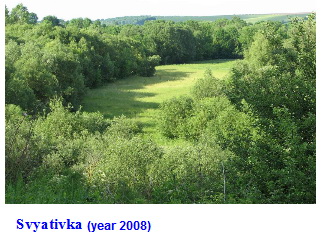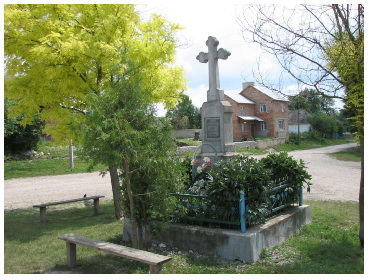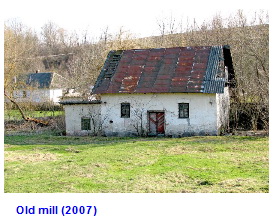| Like pushed between two hills, split in two parts by a small river Viknyna which falls into historical Zbruch, in valley around lush greens - lies the village Faschivka.
"Village Faschivka is located above Zbruch near the border between Galicia and Podolia in the north of slope Medobir. It's a territory of former Skalatskuy district " - such note we read in abstract of Ternopol State Archives.

In the north it borders with the village Tarnorudoyu (Khmelnitsky region) in the south-east (behind Zbruch) - with Postolivkoyu (Khmelnitsky region), in the south - with Mala Luka (Gusyatin district), in the west - with Turivka (Ternopil region). Village is located on the border of three districts and two regions. It seems to be devided on three parts: so-called Dams (western part of the village), which stretch from the last house to the old mill built by Lorber Yos. Savers were in this part a long time ago: water accumulated and turned blade wheel mills - hence is the name.
The central part of the village covered territory from the mill to church and school (with the street from Bernadyn to Slavko).

Svyativka (southern part of the villadge) covered territory from Okonska Anna's house to sandpit "Stinka". In fact it's previous name was Syutivka (because of the first settlement's surname). Before this village belonged to a big Hrymailiv key which covered 30 Podolsky villages and 3 townships. All this was Sinyavsky property. Than - came to Mrs. Rzhevutska's ownership. She sold manor and small town Tarnorudoyu to border storekeeper Bromirskyi.
The country was located below the present mansion Tsymbal. 440 morgues of land was in landowner Leon Bromirskyi's possession. This field stretched to the west from Bashnyanyn John's house. 975 Austrian morgues of land was in peasants possession. Finally this manor was sold because of debts. Such houses as Repka, Lenchuk, Michael Okonskyi, Joseph Domka were built for this money.

Today it's a small village of Pidvolochysk district with 50 houses, where 145 people live whereas there were 171 houses and 950 people in 1924 there.
"Church built at the expense of community in 1867" - such inscription we read on the gable of Blessed Virgin Mary Nativity church. We don't know exactly who was the author of project and we don't know names of masters who built it. But we have materials of Lviv State Historical Archive about the description of church of 1798-1805 (before the stone one was built in 1867). Church and belfry were built from planed wood and covered with shingles. 54 morgues of land was in church possession. In 1867 new stone church was built. It belonged to Luchansk curacy.
Companies. It was time when groups and associations were acted and reading rooms were built in the village. On May 10, 1924 associations " Union of Ukrainian" began to act. Myhalyevych Teklya was elected it's heard. There were also such members: Jaworska, Zadorozhnaya, Nebesna, and others. This union was acting to April 24, 1937.

On January 22, 1925 the reading room of "Enlightenment" was created. Okonskyy, Hawrylyshyn, Kopach were the founders of readings and Havrylyshyn, Hook, Koziy and other - were its members. The meetings hold in Krasutskyi John's , Mary Syuty's houses, Reading Home. I want to note that the first reading room was built during Ausrtian times and was located on previous grave's place. There was also a cellar for temporary imprisonment of guilty people. In 1935 new Ukrainian Reading was built. Plaque for its roof was presented by Zadorozhny Pawlo (his life was tragic: he was the first who came on the gathering when front moved to the west during mobilization. NKVD representative called him from the rank, put on a cart and transported in unknown direction. Nobody knows what happens with him after that. The reason of this event is obvious - the man was a leader of OUN. Polish reading room was built in this years too (village club is there now). At the end of the war "jumps" gathered there ("fighter garrison").
Om May 21, 1929 charter of "farmers mug" was registered. It was acting to November 22, 1938.
On June 20, 1929 the association "Country Host" was founded. It's members: Panteleimonovich, Hook and others. The meetings hold in reading room of "Enlightenment", houses of Krasutskiy John, Okonskyi Michael.
In 1932 the group "Native School named after Bogdan Khmelnitsky". Fedyshyn John was it's founder. Valid government tried to prohibit the establishment of this association. It's obviously from characteristics of the group members and documents of the county authorities in Skalat (Starostwo Powiatowe) presented us by the organizer John Fedyshyn.
So on January 1, 1930 a library of "Education" association and cooperative "Consent" were acting. There were also 250 free Ukrainian books for members of association.
On May 1, 1930 a library of "National School" association was acting. It was founded in 1924. There were 140 Polish books for its members. 24 readers accrued there.

On August 24, 1991 Republican parliament passed the Act of the Independence of Ukraine almost unanimously. The activity of the Communist Party was terminated because of the complicity in coup attempt. The monument was established in the centre of the village in honor of this event.
Liturgies in our church were renewed since 1989. The church roof and domes were renovated thanks to the efforts of church brothers Hawrylyshyn Joseph, Holowka Sviatoslav, Koziy Theodore who dealt with all organizational issues. The cross on the dome of our church was restored by village blacksmith (Koziy T.J.) previously have been made by his father ( blacksmith too).

In 1990 iconostasis was covered with gilded and in the next 1991 church plastered surface were restored (repair was made by Habryyeliv Michael, Theodore Bodnar). At the same time all paintings inside the church were renovated by the artist Irina Gonchar. In 1992 Sich Shooters grave was constructed. In 1945 on the place of many inhabitants' tragic death was also installed the figure (on Stinka). Their names were minted on the tombstone. Except all terrible events of these years I would like to distinguish two tragedies.
Stinka. Such title has a sandpit where the civilians of our village were buried alive by NKVD. They exploded this people who hided in deep tunnels from the mobilization to the army. The tragedy occurred on April 4, 1945. Imagine that more than 23 people died a horrible death. They slowly suffocated, squeezed deep into the sand. According to other sources there was also rebels cache that's why much more people died. These tunnels were created as a result of manual extraction of sand by Kvasnytsya family. More details about this tragedy you can read here: Fashchivka-Stinka
Pentecost. A terrible tragedy held on the second day of Pentecost in 1945. This year it was celebrated late - on June 24 . On June 25, 40 rebels arrived to the village to meet with other fighters who came before. Somebody reported NKVD command about it. As a result two garrisons of Skalat and Pidvolochysk soldiers and at the other side of Zbruch - from Gorodok district were sent to Faschivka. The number of soldiers (near 600) dominated by the number of insurgents so much. Shooting began above Mahobey yard between Holubennoyi Anna's and Kendyforskoyi's houses (now it's a small lawn). During shooting one of the rebels who was already wounded in the leg got to Mutsa Michael's house and hid on the loft. Shooting began. House was set on fire. Michael (owner of the house) jumped through the window and run towards the river. He understood that he can be blamed for giving a refuge to rebel that's why began to escape. But the bullet caught him. More than 22 rebels were killed in this fight.
Tuesday after Pentecost. It's so hot. Corpses were brought near Mykola Nebesnyi and put them into lines from Slavko's garden. More than 22. Cadaverous stench was so felt. Swarm flies sat on the murdered bodies. Garrisoners took some people to identify killed. One of them refused to call the names (perhaps he didn't know) as a result he was beaten with groves until fell down.
Young boys all over the village dug a big hole. Koziy Yakiv and Slavko Danulo began to form rows of dead bodies in dug pit. But the NKVDs shouted that it is nothing to mess with bandits. So bodies were just thrown in. The tomb on village cemetery with minted names: Muts, Holubennyy, Dominiw - is also a tomb for 22 young lives. They were tragically ended in such a great day of Pentecost 45th. Our peaceful people also suffered from "night bandits" who steal in Ukrainian and Polish houses and drowned, hanged, murdered whole families. Here are some victim families: Hes, Poliak, Zajac, Fedyschyn, Kendyforski, Kovalchuk, Dudnevych, Cyriliv, Burak, Slavko and others.
Time goes by and erase from memory details of these terrible events of war.
*****
Among greens of willows and maples, among May morning songs of nightingale a narrow beauty-river Viknyna runs through the village. On the west the river passes quagmires which nourish it with cold sources water, passes meadows and pastures, people's gardens, lush old mill thickets. What is its name from?

On the map it called Turavka (or Turivka), probably because the beginning is in the neighbor village. But all Faschivka inhabitants call it Viknyna. According to the legend, beginning of the river is near the village Vikno (Husyatun district). A long lond time ago (not to check when) one Mr. threw the river eel in one of the sources. It was caught already in Viknyna near Turiv. So the name of the river came from the name of the locality. But it's just a legend. It is questionably that this trickle could break through the rocky ridge Medobir shared these two villages. Maybe small sources filled it like windows (in Ukraine - vikno) reflected blue sky. So here is the name - Viknyna. Maybe...

Village dyes. Today (on October 2012) the number of houses is 50. 149 people live there. 53 of them are pensioners. 50 houses are empty (including ruined). This short information will be edited and supplemented by various details of Faschivka's history. That's why we ask everyone who read it: send stories you have heard from your parents and older generation about the events of our village. Complement the history of village. Time goes by and we are not immortal. So let our descendants know the names of those who lived here, worked, died and left good deeds. |












